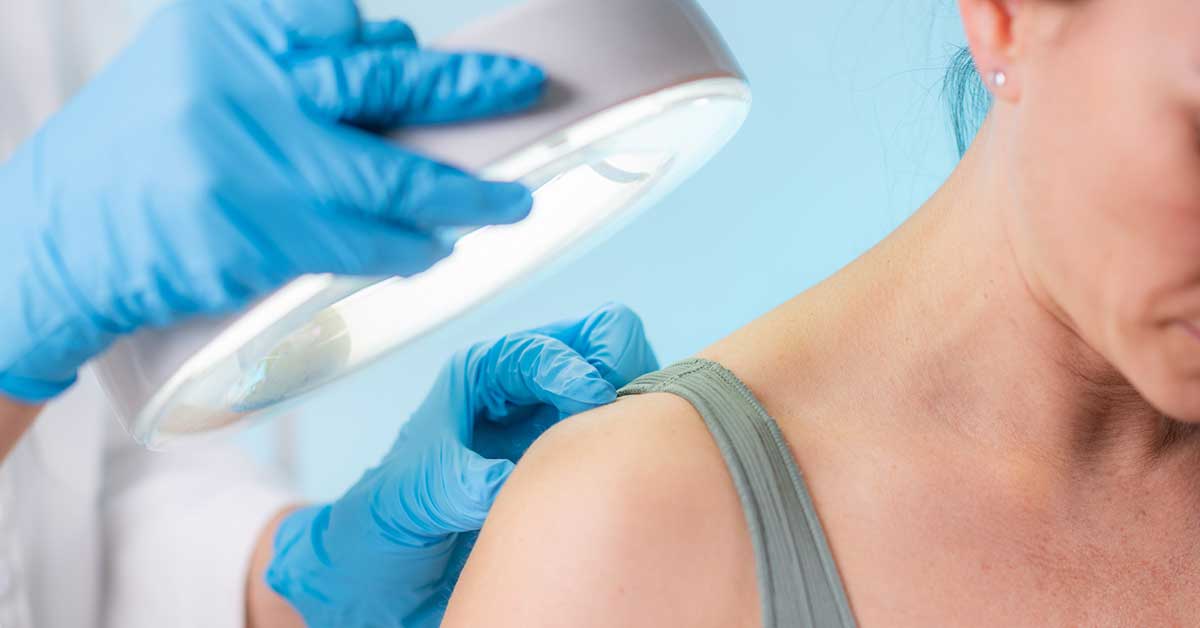Unusual Places You Can Get Skin Cancer

Could that spot under your fingernail be skin cancer?
Should you worry about a mole that never sees the sun?
You may be aware that skin cancers often occur in areas of the body that get the most UV exposure – essential knowledge for skin cancer prevention and cancer care in Florida. But the signs of skin cancer can appear on any body part – even if those areas don’t typically see daylight.
These hard-to-see spots can go undetected and escape early intervention. That’s why it’s important to know that melanoma and other skin cancers can appear wherever there are pigment-producing cells.
Here are just some of the unusual and unexpected places that skin cancer can strike and what to look for.

Under a Fingernail
Melanoma, also called subungual melanoma, can appear under a fingernail or toenail. The thumb and big toe are common areas for this type of cancer. Signs of fingernail cancer may appear as a black or brown vertical line and may spread slowly under the nail plate. Cancerous spots underneath nails are often mistaken for bruises or fungal infections. However, unlike an infection, sublingual melanoma usually affects one nail at a time and does not grow out with the nail like a bruise does.
You are most exposed to UV rays during the hottest, sunniest part of the day. But exposure to UV rays happens in other ways, too. If you have your nails done regularly at a salon, the lamps they use emit UV light. These lights can damage DNA and lead to cell mutation over years of exposure. If you frequent the nail salon, use a broad-spectrum sunscreen of at least 30 on your hands each time. If you have manicures frequently, allowing nails to air-dry naturally or using a fan without UV lights is the safest option.

Soles of Feet and Palms of Hands
Although your palms and the bottoms of your feet don’t receive much sun exposure, skin cancer is still a possibility. The most common type of skin cancer in these areas is melanoma. Melanoma on the sole of your foot or on the palm of your hand may look like a mole, blister, plantar wart, bruise, or other minor condition. It may also begin as a flat dark patch that looks different from the skin surrounding it.
Cancerous spots on the foot are typically black, brown, orange, or red in color. Sometimes the spot may even look like an open sore that can itch, crack, or bleed. On the palms of your hands, this type of skin cancer may appear as a small nodule on the skin that is often tan, brown, or white in color. Nodules can scale, bleed or look like an ulcer on the palm.
Cancer on the soles of feet and palms of hands are more common in people with darker skin, where spots and lesions are harder to see. These types of melanomas are often discovered in an advanced state, which makes them more difficult to treat. You can lower your risk of developing skin cancer in these areas by limiting your UV exposure – whether that’s through outdoor activity, tanning beds and even UV-powered pedicure dry lights.

The Eyelids
Another important location to watch for skin cancer – the eyelids. Non-melanoma cancers, such as basal cell, squamous cell and sebaceous carcinoma, are the most common forms of eyelid cancer.
Some signs to watch for with basal cell, squamous cell and sebaceous carcinoma cancers on the eyelid include changes of appearance on your eyelid, any swelling or thickening of the skin, chronic eyelid infections or any colorless mass in or on the eyelid.
While melanoma certainly can develop on the eyelid as well, it’s not as common as other skin cancers in this area. Melanomas can also form in the eye itself. Although rare, melanoma is the most common intraocular cancer in adults. This means malignant cancer cells are present in the soft tissues of the eye.
Melanoma symptoms include a dark area that appears in the colored iris around the pupil and blurry or spotty vision. This is an aggressive type of cancer that can spread to the lymph nodes and throughout the body. Immediate treatment by a medical oncologist is necessary. The approach to treatment depends on the stage of the cancer and the size and location of the tumor.
The main risk factors for eyelid cancers are generally similar to the risks for skin cancer– the top two being UV exposure and family history. Additionally, demographics associated with higher risk include people with light-colored eyes, Caucasians, males and old age. Certain occupations – such as welders, farmers and chemical workers – are also at higher risk of developing melanoma due to on-the-job exposures.
Contact Us
The Tongue
Cancer of the tongue is more common in individuals who smoke, use tobacco or drink alcohol excessively. Many times, dentists are the first to notice signs of tongue cancer and refer patients to a doctor or cancer specialist for screening. Common signs of tongue cancer include a hard white patch on your tongue (a condition called leukoplakia) or patches you can’t brush away or scrape off, these could indicate squamous cell skin cancer. Other symptoms may include a sore or lump on the tongue that doesn’t go away, loss of feeling or tingling. The first step after a tongue cancer diagnosis is often surgery to remove the lesion. Early detection is key, regular dental and skin cancer checks can help spot tongue cancers at an early stage and allow for quick intervention.
Inside and On the Ear
In some cases, skin cancers can form on the outer ear and spread to the inside of the ear, including the ear canal. The most common type of ear cancer is squamous cell carcinoma. However basal cell, melanoma, adenoid cystic and adenocarcinoma cancers can also form in the canal, inner or middle ear. Your ear canal extends from the outer ear, through the middle ear and into the inner ear. Cancer in this area of the body can go undetected. If you notice any unusual spots or sores on your outer ear, experience ongoing discomfort inside your ear, or even limited or loss of hearing, see your doctor right away. Skin cancer on your ear may present itself in several different forms, such as scaly patches of skin around the ear, white bumps on the outer ear, discharge coming from the ear canal, and brown or black lesions or growths.
The Scalp
Most cancers of the scalp are non-melanoma cancers like basal and squamous cell carcinoma. However, melanomas can still develop on the scalp and spread quickly. Because skin cancer in this area is often hidden by hair, it may not be detected until it has advanced to a later stage. The scalp is also rich in blood vessels, making it easy for cancer to grow. A spot or irregular mole on the scalp can be difficult to identify on your own. Scheduling a yearly skin cancer screening is the best way to detect basal and squamous cell carcinoma, and melanoma of the scalp before it can spread.
The Lips
Your lips have near-constant exposure to UV radiation, making you more susceptible to developing different types of skin cancers in that area. The most common form of lip and oral cavity cancer is squamous cell carcinoma. This type of skin cancer can develop on the upper or lower lip, although they occur more frequently on the lower lip and gums. Skin cancer on the lips may appear as a flat or raised area that looks white or light in color. Other signs include a lump or thickening of skin on the lips, gums, or mouth. A sore that doesn’t heal, pain, numbness, or tingling of the mouth can also be indicators of oral cancer. The most common risk factors for lip cancer include fair skin, tobacco use, excessive sun exposure, and a weakened immune system. Using a lip balm with SPF can help protect your lips and reduce your risk.
Learn More about Skin Cancer
Skin cancer can strike any area of the body. Although it most commonly develops in sun-exposed areas, it’s important to stay aware of the hidden places it can appear in as well. If you’d like to learn more about how to decrease your skin cancer risk, read more in our “Signs of Skin Cancer” article.





Comments